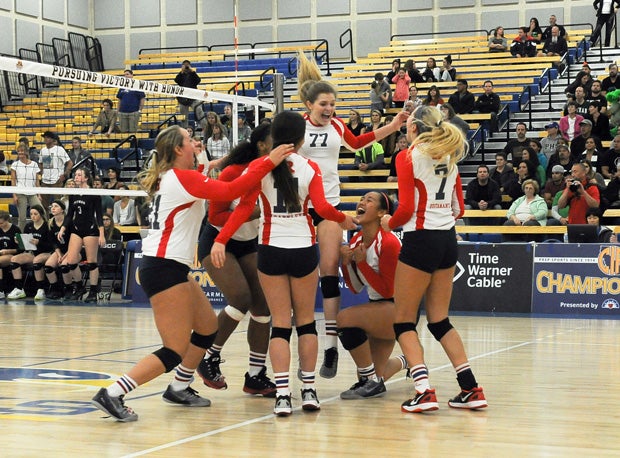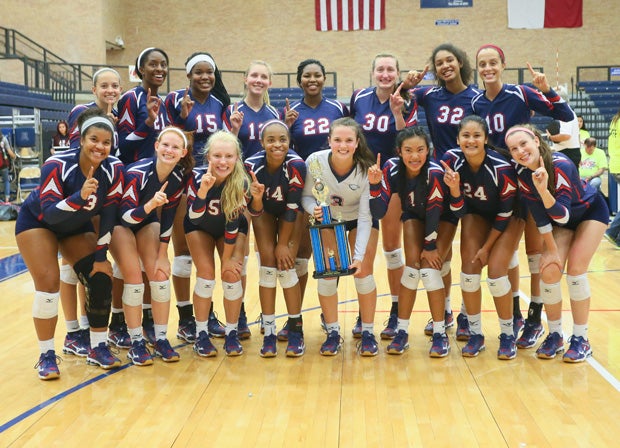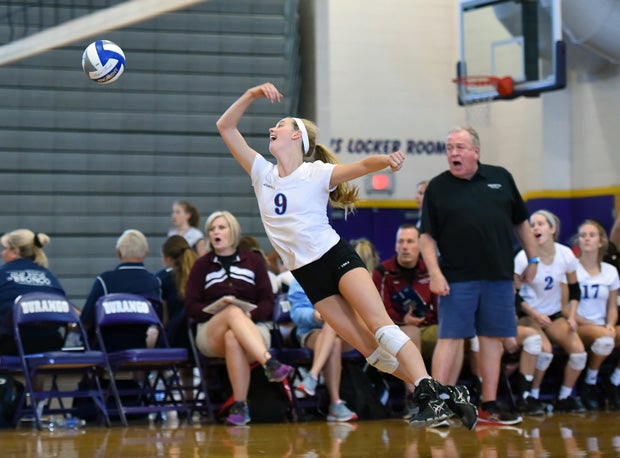Video: Xcellent 25 Volleyball Rankings presented by the Army National Guard: October 20
One reason it has become so difficult to win high school volleyball state titles in California, Kentucky, Texas and Indiana is because of parity. Another is the year-round club impact that is creating more talent and experience at an earlier age.
And, of course, there's team chemistry, avoiding injuries, and a bit of luck.
In California, they are "eating our young," as defending Division I champion
Redondo Union (Redondo Beach, Calif.) coach Tommy Chaffins describes it.
In Texas,
Carroll (Southlake, Texas) coach Ryan Mitchell attributes the parity to "kids being introduced to the sport – and club volleyball – at early ages."
In Indiana, volleyball has become the No. 1 girls sport. The better athletes are choosing volleyball.
And in Kentucky, all routes to the state title game go through Louisville's powerful parochial schools
Assumption (Louisville, Ky.),
Sacred Heart (Louisville, Ky.) and
Mercy (Louisville, Ky.), which beat up on one another on a regular basis.
Despite traditions and talent, winning a title in any state is no easy task. The years of one team dominating year-in and year-out are over.
"There is definitely a little luck involved, as people need to stay healthy, not be selfish and keep a team-first attitude," said Brian Wheatley, who owns a couple of state titles at
Venice (Fla.). "Usually there will be one match in the playoffs where you will have to make that last-second, come-from-behind win. Moreover, there is a ton that goes into winning the whole thing. It's never by accident and extremely hard to do.
"Each time we have won it and reflected back, it's hard not to think of all the intentional work of creating a culture where kids thrive and want to run through a wall for their teammates and keep personal agendas away."
He's quick to add parity is spreading.
"It is getting harder and harder to win because coaching has gotten better, more kids are playing year-round and starting the sport at an earlier age than in the past," Wheatley said.
According to the
MaxPreps Computer Rankings presented by the Army National Guard, 18 of the Top 25 teams come from California (six), Texas (seven), Indiana (three) and Kentucky (two). In the Top 50, 31 are from those states. And in the Top 100, more than half (58) come from Texas, California, Kentucky and Indiana. It simply doesn't get more challenging than that.
Here's a quick look at states where winning a championship in its largest division is always extremely challenging.
California
Redondo Union won the California Division I title last season.
Photo by Daryl Chan
There are more than 5,000 high schools in California and nearly every one has a volleyball team. In Southern California, California Interscholastic Federation participation in Los Angeles, Southern and San Diego sections totals more than 850 teams.
And 135 of those make up the state's largest division.
The southern California sections are so talented that Chaffins says "second-round losers would probably win every other division in California.
"There is no playoff bracket like the one in the Southern Section 1AA playoffs," said Chaffins.
While only two teams have repeated as state champions -
Palo Alto (Calif.) in the north and
Los Alamitos (Calif.) in the south - in the last 10 years, only two NorCal teams have a state title during that span, with
Granite Bay (Calif.) joining Palo Alto.
In short, it doesn't matter what part of the state you are from, making the finals is difficult. But advancing out of the Southern Section is a monumental effort.
"There is so much parity in California," said
Great Oak (Temecula, Calif.) coach Mark Motluck. "Everyone plays club, many have trainers, coaches are experienced and knowledgeable about the game, and scouting is easier to do now with technology and evaluating data."
Motluck, who has guided Great Oak to a 15-1 season and Top 25 national ranking, added, "Matches can be decided by just a few plays, so maintaining a high level of play consistently is going to be key for whoever wins those matches."
Picking a clear-cut favorite in California is like choosing a winning lottery ticket.
Torrey Pines (San Diego),
Santa Margarita (Rancho Santa Margarita, Calif.),
Corona del Mar (Newport Beach, Calif.),
Aliso Niguel (Aliso Viejo, Calif.),
Santiago (Corona, Calif.), Great Oak and Redondo Union would be logical picks in 2015. Each has a roster full of future collegiate players. All are from Southern California.
That's certainly not a knock against NorCal teams, but the top squads north of Fresno are in lower divisions.
Archbishop Mitty (San Jose, Calif.), owns a state-record 11 titles in Division II and has won the last three, but coach Bret Almazan-Cezar feels the accomplishment of reaching the state final is comparable to winning a state title in most states.
"You qualify for sections, win sections, get to regionals, win regionals, and then you have a state match," said Almazan-Cezar. "Because of the abundance of teams, just winning a section is like winning a state championship in other states. Look at the Southern Section, Central Coast Section and Sac-Joaquin Section, that's a lot of competition."
Indiana
Photos by MaxPreps photographers / Graphic by SocialRecluse Graphx
Indiana is home to unbeaten and No. 1-ranked
Cathedral (Indianapolis), but coach Jean Kesterson's team was favored to win the 4A state title a year ago and lost in the finals to
Carmel (Ind.).
Kesterson, who has more than 800 career wins at Cathedral, is quick to point out that volleyball, not basketball, is the No. 1 girls sport in Indiana.
"A team has to be ready to compete every night. A rising tide raises all ships," she said.
Kesterson owns 10 state titles, but hasn't won one since 2008.
There was a time in Indiana when the state champion would come from Muncie.
Muncie Central (Ind.) in 4A and
Muncie Burris (Ind.) in 2A combined for more than 30 state titles in the last 40 years. But Central last won the 4A title in 2009 and Burris the 2A title in 2010.
More athletes, better coaching and more exposure throughout the state has set the stage for eight different champions in the last 10 years.
"The quality of athletes drawn to volleyball has continued to increase as the popularity and exposure of volleyball in the state has increased," said Kesterson, who has been Cathedral's head coach since 1990. "The Big Ten network and the quality of the Big Ten teams has shown our younger athletes how the game can and should be played."
Kesterson added that the quality of coaches throughout the state has helped develop young athletes to play the game at the highest level. And experienced coaches have helped mentor some of the newbie coaches on the "ins and outs of developing a quality program."
"It is especially noticeable this year," she said. "The quantity and quality of teams in Indiana that we have to play night in and night out is incredible. Sometimes I feel like we're competing in the Big Ten. I do have to admit it's really fun this year because there is incredible volleyball being played in the state this year."
While this might be Kesterson's best team ever, four other Indiana teams have been ranked in the Top 25 at some point this season. And like Cathedral, they are loaded with future college players, who on any given night can dominate a match.
To repeat, Carmel has to beat Cathedral – the current top team in the country. That'll be a tall order for the 20-11 Greyhounds.
Since 2010, only three schools have won back-to-back state championships in their respective classes (D1, D2, D3, D4) with 20 state champions crowned during that time frame.
"It is extremely hard to dominate year-to-year because of the number of quality programs in Indiana," added Kesterson.
Texas
Allen is a contender for a Texas state title this season.
Photo by Gregory LaGrange
Carroll (Southlake, Texas) coach Ryan Mitchell knows a lot about winning state titles. He won five titles (in divisions 3A and 4A) at Lovejoy, where he lost just 14 matches in seven seasons.
Under Mitchell, Carroll went 43-4 in 2014, but lost in the regionals of the 6A state tournament. This season, his squad is 30-3, riding a 22-match winning streak and ranked No. 5 nationally.
Mitchell, however, knows each match is a challenge and every year teams improve.
"In general, the level of volleyball has gotten so much better in the last 10-15 years," said Mitchell. "Kids are introduced to the sport at a younger age with youth programs and with clubs doing introductory programs for young kids. Parents are becoming more aware of the sport and getting involved as well. This passion for the game at a young level has spilled over into the club and high school programs."
Ultimately, the top teams in Texas have rosters filled with future college players.
While
Lovejoy (Lucas, Texas) dominated in 3A and 4A,
Coppell (Texas) (2011-12) and the
The Woodlands (Texas) (2013-14) won back-to-back titles.
Hebron (Carrollton, Texas) won in 2010 and
Amarillo (Texas) won in 2009. Of those four, only Hebron is ranked in the state's Top 15 in the computer rankings.
Mitchell is quick to point out that each is loaded with future college players who have been playing year-round since elementary school and are involved in the sport in an outside capacity as well through club, spring leagues, summer leagues, clinics, and more.
"More kids are participating and getting better and better training is producing more athletes that are skilled at the game," he said. "Even the lowest-ranked teams in high school usually have two or three kids who play at top-level clubs, which results in the ability to upset teams and compete at times with the upper-level teams.
"The highest-ranked schools, they are filled with kids that are at the top of their class in volleyball for their age group. Having these types of dedicated athletes results in a highly competitive environment at the high school level," said Mitchell.
While his team will be favored entering the postseason, Mitchell is well aware that the Dragons will come up against the three teams that beat Carroll during the regular season:
Allen (Texas),
Plano (Texas) and
Clear Creek (League City, Texas). They have combined for just 19 losses and 100 wins this season.
Kentucky
Assumption won the Durango Invitational in Nevada.
Photo by Jann Hendry
California, Texas and Indiana will lay claim to being home to the most talented high school volleyball play in the country, but Kentucky programs can make a strong argument for that honor.
Every season, Louisville powers Assumption, Sacred Heart and Mercy win major out-of-state tournaments and this year was no exception, as Assumption took the Durango Classic in Las Vegas, and Sacred Heart won Chicago's ASICs Invitational.
Just last week, Mercy beat Sacred Heart and Assumption beat Mercy. For the season, Mercy (26-7) has a 1-4 record against its crosstown rivals, while Assumption (28-7) is 3-2 and Sacred Heart is 4-3 and lost to the Rockets and the Jaguars last week for a rare two-match losing streak.
Dating back to 1995, the state title has been won by Assumption, Mercy or Sacred Heart every year.
One of the key reasons for the success of Louisville teams is Assumption coach Ron Kordes, who started the Kentucky-Indiana Volleyball Academy and the Ohio Valley Volleyball Center. Considered one of the nation's premiere youth volleyball clubs, KIWA has produced 47 champions and 135 medal finishes in national competition.
Todd Garvey, who coached Mercy to a 41-1 season and state title in 2014 and is now an assistant at Purdue University, said volleyball players in Louisville start taking the game seriously at age 6, then begin travel ball at ages 7 and 8, thus developing their skills at a very young age.
In a MaxPreps article in 2011, Kordes said, "By the time they get to us, they've played competitively for six or seven years." He pointed out that two or three of those years could be national-level junior play.
"We're really blessed in this area," said Kordes. "Traditions have been established. The top players want to come to these schools."
The only change in the last four years is that there are more players at a younger age getting more experience. But the road to the state title in Kentucky still goes through Louisville - a problem for every other program in the state, as Kentucky has a one-class system for state titles.
